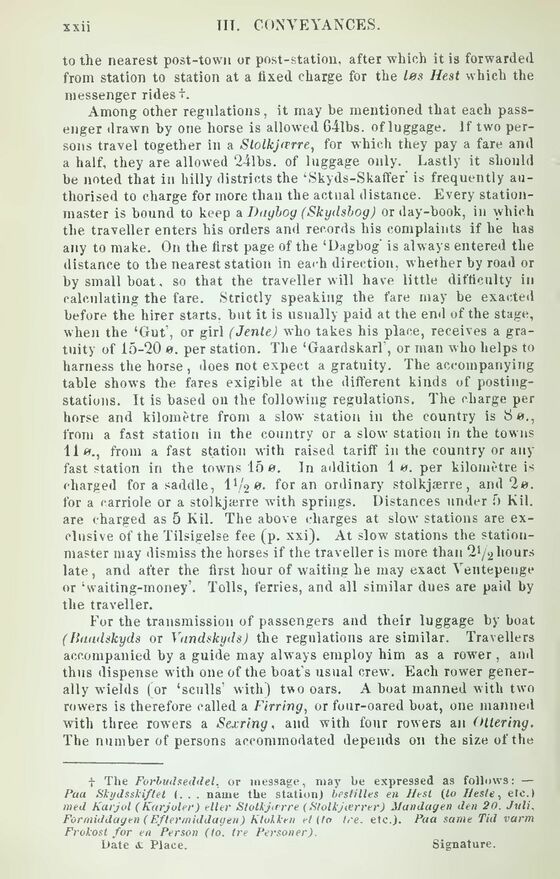
Full resolution (JPEG) - On this page / på denna sida - Introduction - Pages ...

<< prev. page << föreg. sida << >> nästa sida >> next page >>
Below is the raw OCR text
from the above scanned image.
Do you see an error? Proofread the page now!
Här nedan syns maskintolkade texten från faksimilbilden ovan.
Ser du något fel? Korrekturläs sidan nu!
This page has never been proofread. / Denna sida har aldrig korrekturlästs.
to the nearest post-town or post-station, after which it is forwarded
from station to station at a fixed charge for the les Hest which the
messenger rides L
Among other regulations, it may be mentioned that each
passenger drawn by one horse is allowed 64lbs. of luggage. If two
persons travel together in a Stolkjærre, for which they pay a fare and
a half, they are allowed 24lbs. of luggage only. Lastly it should
be noted that in hilly districts the ‘Skyds-Skaffer is frequently
authorised to charge for more than the actual distance. Every
stationmaster is bound to keep a Duybog (Skydsbog) or day-book, in which
the traveller enters his orders and records his complaints if he has
any to make. On the first page of the ‘Dagbog’ is always entered the
distance to the nearest station in each direction, whether by road or
by small boat, so that the traveller will have little difficulty in
calculating the fare. Strictly speaking the fare may be exacted
before the hirer starts, but it is usually paid at the end of the stage,
when the ‘Gut, or girl (Jente) who takes his place, receives a
gratuity of 15-20 o. per station. The ‘GaardskarT, or man who helps to
harness the horse , does not expect a gratuity. The accompanying
table shows the fares exigible at the different kinds of
posting-stations. It is based on the following regulations. The charge per
horse and kilometre from a slow station in the country is bø.,
from a fast station in the country or a slow station in the towns
11 0., from a fast station with raised tariff in the country or any
fast station in the towns 15 0. In addition 1 0. per kilometre is
charged for a saddle, foran ordinary stolkjærre, and 2ø.
for a carriole or a stolkjærre with springs. Distances under 5 Kil.
are charged as 5 Kil. The above charges at slow stations are
exclusive of the Tilsigelse fee (p. xxi). At slow stations the
stationmaster may dismiss the horses if the traveller is more than 21/*>l|purs
late, and after the first hour of waiting he may exact Ventepenge
or ‘waiting-money’. Tolls, ferries, and all similar dues are paid by
the traveller.
For the transmission of passengers and their luggage by boat
(ISaadskyds or Vundskyds) the regulations are similar. Travellers
accompanied by a guide may always employ him as a rower, ami
thus dispense with one of the boat’s usual crew. Each rower
generally wields (or ‘sculls’ with) two oars. A boat manned with two
rowers is therefore called a Firring, or four-oared boat, one Banned
with three rowers a Sexring, and with four rowers an Ottering.
The number of persons accommodated depends on the size of the
i The Forbud seddel, or message, may be expressed as follows: —
Pua Kkydsskiftel (. . . name the station! bestilles en Hest (to I/esle, etc.)
wed Karjol (Karjoler) eller Slotkjtrrre (Stolkjierrer) Mandagen den 20. Juli,
Formiddagen (Eftermiddagen) Klokken el (lo Ire. etc.). Paa same Tid varm
Frokost for en Person (lo. tre Personer).
Date i Place.
Signature.
<< prev. page << föreg. sida << >> nästa sida >> next page >>